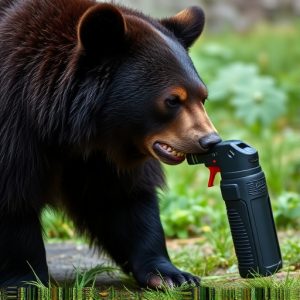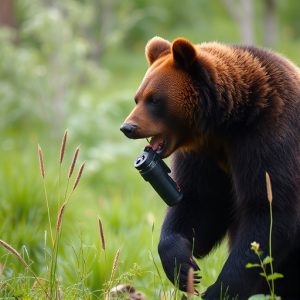Alaska Hiking: Safeguarding Against Bears with Repellent Gear
Bear spray, a vital tool for hikers in bear country, uses capsaicin to deter bears, but its effectiv…….
Bear spray, a vital tool for hikers in bear country, uses capsaicin to deter bears, but its effectiveness is environmentally contingent. The decomposition of bear spray ingredients like capsaicin can impact aquatic environments and soil microbial communities. Responsible usage, proper disposal, and multi-layered protection strategies are essential to balance the spray's deterrence with minimal environmental harm. Understanding the Environmental Effects of Bear Spray Decomposition is crucial for hikers in Alaska's wild landscapes.
“Alaska’s rugged landscapes attract hikers seeking adventure, but they also play home to bears. Navigating ‘bear country’ requires more than just knowledge; it demands the right gear, especially effective bear repellents. This guide delves into the essential components of bear safety, focusing on bear spray. From understanding its composition and effectiveness to exploring the environmental impact of bear spray decomposition, we equip hikers with insights for responsible adventures in Alaska’s breathtaking wilderness.”
- Understanding Bear Spray: Composition and Effectiveness
- The Environmental Impact of Bear Repellents: A Closer Look
- Deconstructing Bear Spray Decomposition: What Happens Over Time?
- Choosing the Right Gear: Beyond Bear Spray for Alaska Hikers
- Best Practices: Ensuring Safety in Bear Country
Understanding Bear Spray: Composition and Effectiveness
Bear spray, a potent deterrent, is a vital component of hiking gear for those venturing into bear country. Understanding its composition and effectiveness is crucial when considering its role in protecting against potential encounters with aggressive bears. This repellent is designed to create a barrier between the user and the bear, temporarily disabling the bear’s sense of smell and vision.
The active ingredient in bear spray varies but often includes capsaicin, the same compound that gives chili peppers their heat. When sprayed, it irritates the bear’s eyes, nose, and respiratory system, causing it to flee. However, it’s essential to note that the Environmental Effects of Bear Spray Decomposition play a role in its overall effectiveness. Factors like weather conditions, surface area coverage, and the bear’s individual sensitivity can impact how well the spray performs. Therefore, proper usage techniques and regular updating of spray equipment are key to ensuring maximum protection during outdoor adventures in bear habitats.
The Environmental Impact of Bear Repellents: A Closer Look
Bear repellent products, especially bear spray, have become essential for hikers and outdoor enthusiasts navigating Alaska’s wild landscapes. While their effectiveness in deterring bears is well-documented, it’s crucial to consider the environmental impact of these chemicals. Bear repellents, upon decomposition, can potentially disrupt local ecosystems and affect non-target species. The Environmental Effects of Bear Spray Decomposition are a growing area of concern for ecologists and conservationists.
Commonly used ingredients in bear spray, such as capsaicin or chili pepper extract, may impact aquatic environments when washed off hiking gear or into water bodies during rainfall. These compounds can alter the behavior of fish and other aquatic organisms, potentially affecting their breeding patterns and overall population dynamics. Additionally, the long-term persistence of these chemicals in the environment raises questions about their impact on soil microbial communities and plant life, which are vital for ecosystem health and balance.
Deconstructing Bear Spray Decomposition: What Happens Over Time?
Bear spray is a popular and effective deterrent for encountering bears while hiking or camping in Alaska, but understanding its environmental impact is crucial. When used correctly, bear spray decomposes over time, leaving minimal residual effects on the environment. However, improper disposal or widespread usage can have environmental consequences.
The composition of bear spray typically includes capsaicin, a compound derived from chili peppers, along with other additives like water and propellants. Over time, these components break down naturally, especially when exposed to varying weather conditions in the outdoors. Environmental factors such as temperature, humidity, and sunlight play significant roles in accelerating the decomposition process. Research suggests that bear spray can degrade rapidly within weeks or months, depending on the environment, reducing its effectiveness as a deterrent over extended periods. This natural breakdown is essential as it minimizes the potential for ecological disruption caused by persistent chemical residues.
Choosing the Right Gear: Beyond Bear Spray for Alaska Hikers
Choosing the right gear for Alaska hikes involves more than just bear spray, a common misconception many hikers have. While bear spray is an essential component of any Alaskan outdoor adventure, it’s crucial to understand that its effectiveness depends on various factors, including environmental conditions. The environmental effects of bear spray decomposition can vary; wind and rainfall can quickly dissipate the aerosol, reducing its range and potency. Therefore, hikers should invest in multi-layered protection strategies.
Besides bear spray, consider gear designed with durability and functionality in mind. A sturdy backpack with multiple compartments for easy organization and quick access to essentials is vital. Waterproof clothing and gear are essential to protect against both elements and potential bear encounters, as a wet, soggy hike can be an inviting target for curious bears. Additionally, carrying noise makers or a bell can help deter bears, as they often avoid areas with loud noises.
Best Practices: Ensuring Safety in Bear Country
When hiking in bear country, adhering to best practices is paramount for ensuring safety. One of the most effective tools in your arsenal is bear repellent, specifically bear spray. Unlike other repellents, bear spray creates a barrier that can deter bears from approaching by temporarily blinding and disorienting them through its high concentration of capsaicin. However, it’s crucial to understand the environmental effects of bear spray decomposition. Bear spray breaks down over time and in certain conditions, becoming less effective as its active ingredients dissipate. Proper storage and regular replacement are essential to maintain its potency.
Additionally, knowledge of local regulations and bear behavior is vital. Always hike in groups, make noise to signal your presence, and avoid surprising bears. Keep food securely stored and never leave any trace that might attract bears. Remember, the key to safety in bear country lies in prevention and understanding the natural habits of these majestic creatures, all while respecting their habitat and minimizing the environmental impact of any repellents used.
In conclusion, understanding the composition and effectiveness of bear spray, along with its environmental impact, is crucial for hikers in Alaska. The decomposition process of bear repellent plays a significant role in its performance over time. By choosing the right gear and adhering to best practices, hikers can enhance their safety in bear country while also considering the ecological balance. Knowing the Environmental Effects of Bear Spray Decomposition is key to making informed decisions, ensuring a responsible and secure outdoor experience.


